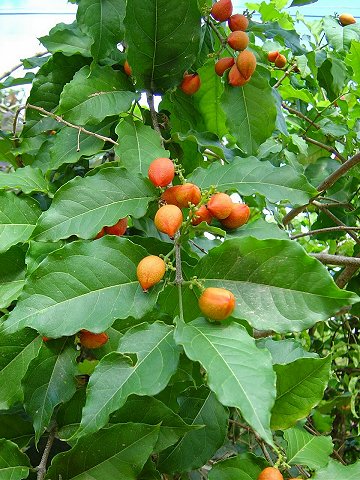
|
|
Peanut Butter tree
(Bunchosia glandulifera).
Leaves and fruits.
|
Peanut Butter tree - Bunchosia glandulifera
Bunchosia glandulifera, commonly known as peanut butter tree, is a species of flowering plant in the acerola family, Malpighiaceae, that is native to Central America and South America. It produces small orange-red fruits of sticky and dense pulp, with a flavour and aroma resembling that of peanut butter. It is mostly eaten fresh, but is also used for jellies, jams or preserves. The superficial appearance of the berries are similar to coffee and in Brazil is accordingly called caferana or falso guarana.
Bunchosia glandulifera has been introduced to the U.S. horticulture as Bunchosia argentea and was further distributed under this name.
Bunchosia argentea, known as silver peanut butter fruit, is a species of flowering plant in the acerola family, Malpighiaceae, that is native to Venezuela, Colombia, Peru, Brazil, Guyana and Suriname. It produces small orange-red fruits that are sericeous (finely haired) of pleasant taste similar to peanut butter. Leaves have pointed ends and are densely silvery or golden sericeous on the abaxial side.
Bunchosia glandulifera is often misidentified as Bunchosia argentea. The main distinctive character is in the leaves. Furthermore, Bunchosia argentea has not been cultivated.
Bunchosia glandulifera grows as an evergreen shrub or smaller tree up to about 7–8 meters high. In cultivation the tree ideally reaches up to 6 metres (20 feet) in diameter, although can be maintained to a smaller size. The bark is grayish-brown, smooth to slightly rough or nodular. The trunk provides
rubber. The leaves are lightly sericeous (hairy) and have wavy edges.
The tree is fast-growing and has some frost-tolerance.
Flowers are small, yellow, arranged in racemes. Fruit is a drupe, 2-2.5 cm long, orange and ripening to red, ellipsoidal, almost smooth, slightly hairy, orange to red, the pulp intensely red, stickly, slightly juicy and sweet; containing 1- or more commonly 2-seeded. Seeds are about 1-1.5 cm long, light brown, elliptical, somewhat flattened on one side, smooth and bony.
The fruits are ellipsoidal, almost smooth, slightly hairy and orange to red, briefly tipped berries with a thin, somewhat rubbery skin. They are about 2–3.5 centimeters long and contain 1 or mostly 2 free, about 1–1.5 centimeters long and light brownish, elliptical, somewhat flattened on one side and relatively smooth and bony seeds. The red pulp is sticky, slightly juicy and sweet. Fruits can be harvested not yet fully ripe, still orange, and then left to ripen for two days, to become red and soft.
Fruit is edible raw. Mostly eaten fresh, also used for jellies, jams, or preserves.
It has a sticky, dense, sweet, pleasant-tasting pulp. About the size of a quail egg, the reddish-orange fruit is not very juicy but has concentrated sugars like a dried fig. Some people have compared the fruit to a cooked sweet potato, whilst it is also sometimes called the peanut butter fruit because its texture, but not its taste, is similar to peanut butter. Additionally, the scent is unmistakably of peanut butter.
In Brazil, the fruit pulp is consumed in its natural state or as juice. Seeds are roasted and ground, and consumed in a similar manner.
Source:
https://en.wikipedia.org/wiki/Bunchosia_glandulifera
https://www.stuartxchange.org/PeanutButterFruit
https://tropical.theferns.info/viewtropical.php?id=Bunchosia+argentea
https://www.growables.org/information/TropicalFruit/peanutbuttertree.htm
